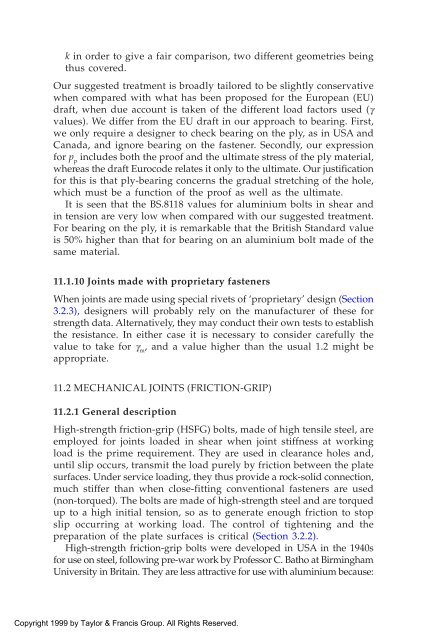Aluminium Design and Construction John Dwight
Aluminium Design and Construction John Dwight
Aluminium Design and Construction John Dwight
Create successful ePaper yourself
Turn your PDF publications into a flip-book with our unique Google optimized e-Paper software.
k in order to give a fair comparison, two different geometries being<br />
thus covered.<br />
Our suggested treatment is broadly tailored to be slightly conservative<br />
when compared with what has been proposed for the European (EU)<br />
draft, when due account is taken of the different load factors used (�<br />
values). We differ from the EU draft in our approach to bearing. First,<br />
we only require a designer to check bearing on the ply, as in USA <strong>and</strong><br />
Canada, <strong>and</strong> ignore bearing on the fastener. Secondly, our expression<br />
for p p includes both the proof <strong>and</strong> the ultimate stress of the ply material,<br />
whereas the draft Eurocode relates it only to the ultimate. Our justification<br />
for this is that ply-bearing concerns the gradual stretching of the hole,<br />
which must be a function of the proof as well as the ultimate.<br />
It is seen that the BS.8118 values for aluminium bolts in shear <strong>and</strong><br />
in tension are very low when compared with our suggested treatment.<br />
For bearing on the ply, it is remarkable that the British St<strong>and</strong>ard value<br />
is 50% higher than that for bearing on an aluminium bolt made of the<br />
same material.<br />
11.1.10 Joints made with proprietary fasteners<br />
When joints are made using special rivets of ‘proprietary’ design (Section<br />
3.2.3), designers will probably rely on the manufacturer of these for<br />
strength data. Alternatively, they may conduct their own tests to establish<br />
the resistance. In either case it is necessary to consider carefully the<br />
value to take for � m , <strong>and</strong> a value higher than the usual 1.2 might be<br />
appropriate.<br />
11.2 MECHANICAL JOINTS (FRICTION-GRIP)<br />
11.2.1 General description<br />
High-strength friction-grip (HSFG) bolts, made of high tensile steel, are<br />
employed for joints loaded in shear when joint stiffness at working<br />
load is the prime requirement. They are used in clearance holes <strong>and</strong>,<br />
until slip occurs, transmit the load purely by friction between the plate<br />
surfaces. Under service loading, they thus provide a rock-solid connection,<br />
much stiffer than when close-fitting conventional fasteners are used<br />
(non-torqued). The bolts are made of high-strength steel <strong>and</strong> are torqued<br />
up to a high initial tension, so as to generate enough friction to stop<br />
slip occurring at working load. The control of tightening <strong>and</strong> the<br />
preparation of the plate surfaces is critical (Section 3.2.2).<br />
High-strength friction-grip bolts were developed in USA in the 1940s<br />
for use on steel, following pre-war work by Professor C. Batho at Birmingham<br />
University in Britain. They are less attractive for use with aluminium because:<br />
Copyright 1999 by Taylor & Francis Group. All Rights Reserved.















